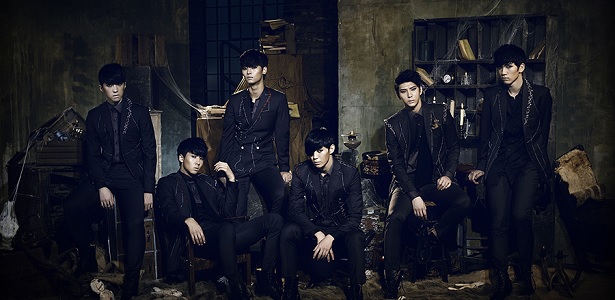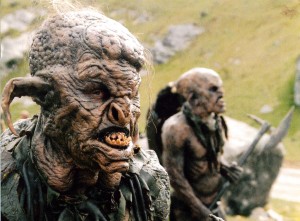 Chills — those shivers of fear running down your spine; there is something inexplicably exciting about them. And so is being wary of dark corners, rethinking your decision to answer nature’s call, believing that something or someone lurks in the realm of the unknown, something called… Monsters. It’s all childish indulgence by day time and unspecified reality by night.
Chills — those shivers of fear running down your spine; there is something inexplicably exciting about them. And so is being wary of dark corners, rethinking your decision to answer nature’s call, believing that something or someone lurks in the realm of the unknown, something called… Monsters. It’s all childish indulgence by day time and unspecified reality by night.
To state the obvious, monsters were conceived with the purpose to scare but not only to scare. Underlying themes of moral and social awareness and consequently, moral and social correction have been made concrete in the image of the monster. The two-dimensional figure of the monster which runs amok in horror stories is usually a grotesque figure haunting the peripheries of civilized society with the sole purpose of wrecking bloody havoc amongst civilized folks with its barbaric lifestyle. Most importantly, this community of monsters involving vampires, werewolves, zombies, goblins, etc. was born monstrous and hence, is beyond remedy.
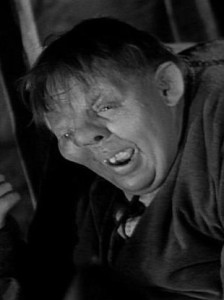 This community which acted as the othered example of all that one should not be and all that one should avoid and if possible, destroy has been deconstructed and resurrected from the pits of silence. Its imperialist and misogynistic discourse has been illustrated and reproved, putting these ‘monsters’ in a better perspective, in texts like Christina Rosetti’s The Goblin Market, Victor Hugo’s The Hunchback of Notre-Dame, Mary Shelley’s Frankenstein, and several more. Tim Burton remains the crusader of the humanization of monsters, re-interpreting them as three-dimensional beings devoid of unnecessary thirst for blood and brimming with kindness and love. Monsters have been portrayed to us as empathizing humans in all their physical monstrous glory reinstating the popular adage: Do not judge a book by its cover. Big Bang’s “Monster,” within K-pop, falls in this old tradition of monsterized monsters.
This community which acted as the othered example of all that one should not be and all that one should avoid and if possible, destroy has been deconstructed and resurrected from the pits of silence. Its imperialist and misogynistic discourse has been illustrated and reproved, putting these ‘monsters’ in a better perspective, in texts like Christina Rosetti’s The Goblin Market, Victor Hugo’s The Hunchback of Notre-Dame, Mary Shelley’s Frankenstein, and several more. Tim Burton remains the crusader of the humanization of monsters, re-interpreting them as three-dimensional beings devoid of unnecessary thirst for blood and brimming with kindness and love. Monsters have been portrayed to us as empathizing humans in all their physical monstrous glory reinstating the popular adage: Do not judge a book by its cover. Big Bang’s “Monster,” within K-pop, falls in this old tradition of monsterized monsters.
However, with the onset of Twilight, we have been assaulted by a slew of ‘new’ monsters. These monsters thrive on physical attraction; pruning, prepping (and sparkling) whenever possible. While they may not be empty vaults of emotions, their emotionality takes second place to how absolutely ‘do-able’ they are. They are not humans neither are they ‘monsters’; this new brand of monsters is of ridiculously attractive super-humans wherein the ‘super’ is attributed only to their heavenly looks.
 Technically, they are not supposed to scare us. I mean what could possibly be scary about a sparkly vampire or a forever half-naked werewolf? But that is the point of these monsters: to be the unknown known. These are monsters not pushed to the fringes by us, the conventional society; these are monsters which unnoticeably emerge from and remain within the society, choosing their unaware victims. Their monstrosity is not defined by their looks (as compared to their ancestors), neither by their crimes because with the redefinition of monsters comes a redefinition of their crimes, crimes which are often forgiven or gone unnoticed because of their pretty faces, their socially acceptable and culturally eulogized faces.
Technically, they are not supposed to scare us. I mean what could possibly be scary about a sparkly vampire or a forever half-naked werewolf? But that is the point of these monsters: to be the unknown known. These are monsters not pushed to the fringes by us, the conventional society; these are monsters which unnoticeably emerge from and remain within the society, choosing their unaware victims. Their monstrosity is not defined by their looks (as compared to their ancestors), neither by their crimes because with the redefinition of monsters comes a redefinition of their crimes, crimes which are often forgiven or gone unnoticed because of their pretty faces, their socially acceptable and culturally eulogized faces.
Pedophilic Edward glorified as a man vampire worth dying for, fangirls sighing dreamily at Goo Jun-pyo wrenching Geum Jan-di’s arm, the trope of “if you like then it’s not rape,” fans chanting that their oppas can never do any wrong — pretty monsters with their varying degrees of monstrosity seem to get away with a LOT of things. K-pop, with its glamorous idols, plays with the idea of easily forgiven good-looking monsters in addition to other effects caused by the humanization of monsters.
Zombies have been a staple of horror concepts since forever. From being portrayed as genuinely preying stiff monsters to caricatures of their scary self, the concept of the zombie lacks flexibility. 4Minute’s “What’s Your Name?” and T-ara’s “Lovey Dovey” help humanize and deconstruct the idea of zombies.
[youtube https://www.youtube.com/watch?v=H-IJWqIHioA]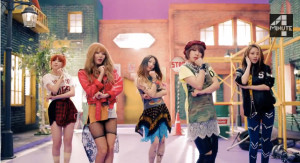 In both these MVs the supporting dancers as well as the idols are young people ranging from their teens to mid twenties; pretty much the age group most fans belong to. It, then, instantly becomes a representation of us — of the current generation and the next — and our lifestyle. This representation of our lifestyle or desired lifestyle is set in a club in T-ara’s case, and a makeshift one in 4Minute’s case, and nothing better than a club describes the entertainment hub of a consumerist economy. Nothing better than a zombie describes the victim of mindless consumerism.
In both these MVs the supporting dancers as well as the idols are young people ranging from their teens to mid twenties; pretty much the age group most fans belong to. It, then, instantly becomes a representation of us — of the current generation and the next — and our lifestyle. This representation of our lifestyle or desired lifestyle is set in a club in T-ara’s case, and a makeshift one in 4Minute’s case, and nothing better than a club describes the entertainment hub of a consumerist economy. Nothing better than a zombie describes the victim of mindless consumerism.
Zombies are of course us humans back from the dead but several critics believe that zombies are not aimless, goalless, human meat savouring monsters. They are instead the mirror image of our consumerist self. The skinny frame, sunken cheeks represent the money sucking policies of a consumerist economy while the hollow eyes represent our clouded vision. The zombie, with its outstretched hands, looks every inch like an addict we are familiar with (hint: K-pop goods).
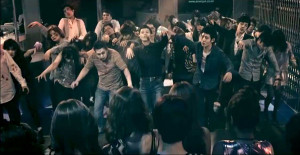 Several philosophers have also come up with idea of the “philosophical zombies” which basically theorizes that zombies are exactly like us, devoid of physical monstrosity and complete with physical and emotional human qualities, except they lack conscious experiences. This concept of the human self lacking consciousness ties up well with the confessions of any shopaholic and justifies the presence of a dolled up 4Minute and T-ara because after all, the change has taken within them. The odd note, however, lies with the supporting dancers. Not completely repulsive they are represented as far more grotesque than the idols themselves raising one pertinent point: Does even a concept not allow idols the freedom of being ‘ugly’?
Several philosophers have also come up with idea of the “philosophical zombies” which basically theorizes that zombies are exactly like us, devoid of physical monstrosity and complete with physical and emotional human qualities, except they lack conscious experiences. This concept of the human self lacking consciousness ties up well with the confessions of any shopaholic and justifies the presence of a dolled up 4Minute and T-ara because after all, the change has taken within them. The odd note, however, lies with the supporting dancers. Not completely repulsive they are represented as far more grotesque than the idols themselves raising one pertinent point: Does even a concept not allow idols the freedom of being ‘ugly’?
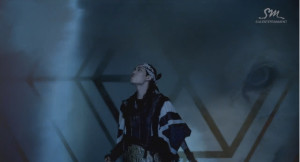 Leaving the zombies to work out their flexibility and salon appointments, I shall briefly gloss over the concept of werewolves. They are, I guess, the second most popular monsters after vampires but unlike vampires, they do not traditionally have the beauty imperative. SM believes it’s a tragic flaw and introduces the “Vampwolves,” also known as EXO. “Wolf” honestly portrays the conditioned monster of the chauvinistic K-drama hero and adds to it the conceptual monster of the “Vampwolf” and unfortunately, the end result is humanized monsters who desire “cheesy” women, and squealing, besotted fangirls. Under the protective umbrella of the animalistic wolf and the predatory vampire, these very human boys commit very human violence and all one can see is “so manly!”
Leaving the zombies to work out their flexibility and salon appointments, I shall briefly gloss over the concept of werewolves. They are, I guess, the second most popular monsters after vampires but unlike vampires, they do not traditionally have the beauty imperative. SM believes it’s a tragic flaw and introduces the “Vampwolves,” also known as EXO. “Wolf” honestly portrays the conditioned monster of the chauvinistic K-drama hero and adds to it the conceptual monster of the “Vampwolf” and unfortunately, the end result is humanized monsters who desire “cheesy” women, and squealing, besotted fangirls. Under the protective umbrella of the animalistic wolf and the predatory vampire, these very human boys commit very human violence and all one can see is “so manly!”
 After all this theorizing, criticizing and cultural decoding, I bring to you VIXX, the unquestioned masters of the gory, grotesque and the new school of monsters. From the shaky, not-so-convincing “Vampwolves” in “On and On” to the chilling “Voodoo Doll,” VIXX is on the right path of redefining monsters. “Hyde” portrayed a conflicted monster slowly turning monstrous. The conflict is shown spectacularly in Leo as he tries to stop himself from killing (?) the woman. Conditioned monstrosity, the inner humanization of monsters and the untidy dark makeup, “Hyde” took scary to a whole new level. “Voodoo Doll” despite not using the symbol of the monster (voodoo dolls are agents of Evil) manages to evoke disgust, repulsion and dread — staples of horror — in us with buttery ease. But the issue I began with, of evoking sympathy for the plight of monster idols just because the idol sings “I’m not a bad person, I love you” gnaws at righteous conscience. The music videos don’t offer a scope for redemption but yearn for acceptance despite committing visceral violence.
After all this theorizing, criticizing and cultural decoding, I bring to you VIXX, the unquestioned masters of the gory, grotesque and the new school of monsters. From the shaky, not-so-convincing “Vampwolves” in “On and On” to the chilling “Voodoo Doll,” VIXX is on the right path of redefining monsters. “Hyde” portrayed a conflicted monster slowly turning monstrous. The conflict is shown spectacularly in Leo as he tries to stop himself from killing (?) the woman. Conditioned monstrosity, the inner humanization of monsters and the untidy dark makeup, “Hyde” took scary to a whole new level. “Voodoo Doll” despite not using the symbol of the monster (voodoo dolls are agents of Evil) manages to evoke disgust, repulsion and dread — staples of horror — in us with buttery ease. But the issue I began with, of evoking sympathy for the plight of monster idols just because the idol sings “I’m not a bad person, I love you” gnaws at righteous conscience. The music videos don’t offer a scope for redemption but yearn for acceptance despite committing visceral violence.
The shift from the perception of monstrosity as characterized by the grotesque to the highly romanticized humanized rendition of evil incarnate is therefore extremely problematic, for it deeply muddles the ethos of ethicality endorsing an acceptance and wide-eyed admiration for beautifully evil faces. It is important to realize that my liberal use of good looks and one’s understanding of it does not preach a particular idea of beauty but is flexible based on one’s social and cultural conditioning. Beauty is subjective, and therein lies the problem of blaming culturally and physically disapproved people as monsters but ignoring the crimes of culturally and physically empowered people — which is why one needs to gravitate towards a more universally grotesque portrayal of ‘monsters’ even while humanizing them, because accepting people in all shapes and sizes seems to be quite a Herculean task.
(Youtube [1] [2] [3] Litreactor, Daily Mail, The Sociological Cinema, Kirk, Robert and Squires, Roger. “Zombies vs. Materialists”, Tanney, Julia. “On the Conceptual, Psychological, and Moral Status of Zombies, Swamp-Beings, and Other ‘Behaviourally Indistinguishable’ Creatures”. Images via narnia.wiki, runslikeagay, hdwallpapers, Core Contents Media)
